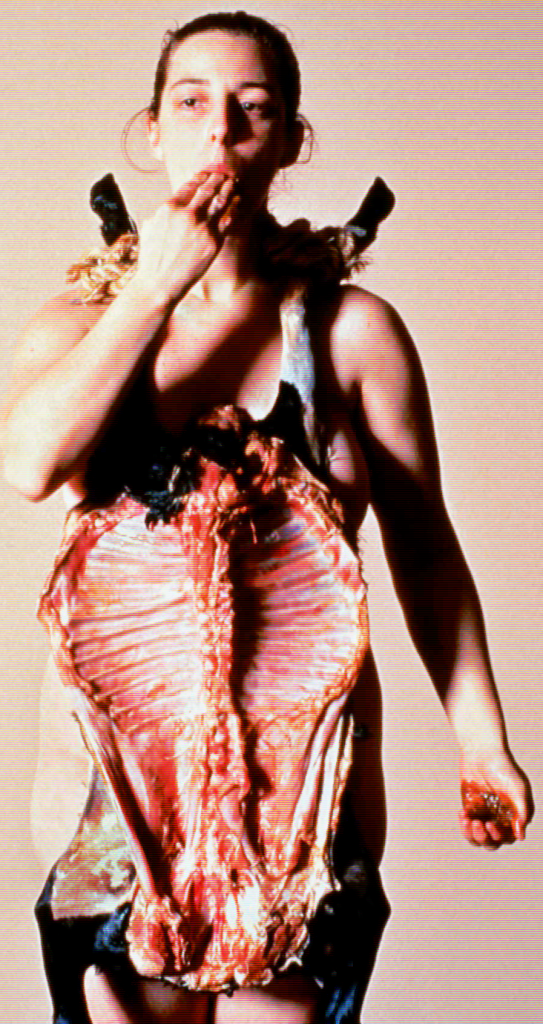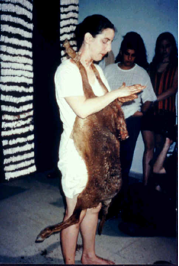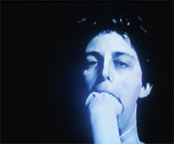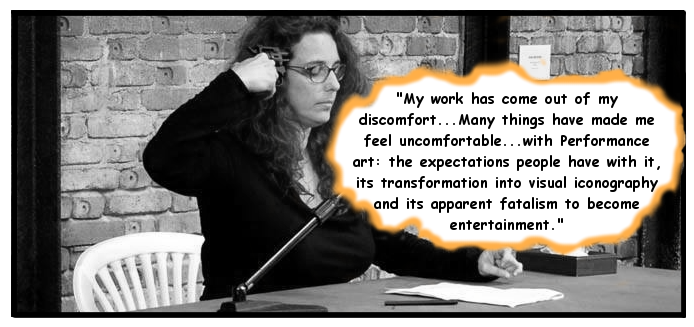
Tania Bruguera is a controversial performance artist of international acclaim. Born in Havana, Cuba in 1968, Bruguera grew up in a time when Cuba’s relations with the global community, and the United States in particular, were strained. Receiving degrees from the Cuban Instituto Superior de Arte and the American School of the Art Institute of Chicago, Bruguera would eventually establish residences in both Havana and Chicago, travel the world, and receive awards and academic acclaim both for her artwork and for her efforts as a public speaker, political activist, and founder and director of Arte de Conducta, the first Cuban performance-art program.
Bruguera’s art is generally performance-based. Some of her most famous and politically/socially inflammatory pieces involve her wearing disquieting costumes while abusing herself or opening herself up to public ridicule and pity. In fact, as best as I can tell, every piece she’s ever done has involved making herself and her audience uncomfortable and uneasy. Here is a brief overview of some of her major works.
Major works
 El Peso de la Culpa (The Burden of Guilt) was, until recently, Bruguera’s most well-known and provocative piece. In this 1997 performance, the artist wraps herself in the flesh of a decapitated lamb and, sitting before a giant Cuban flag woven from human hair, consumes dirt and salt water for three-quarters of an hour in homage to the Spanish-conquered native Cubans who consumed the concoction in deadly quantities as the suicide ritual of a conquered and hopeless people.
El Peso de la Culpa (The Burden of Guilt) was, until recently, Bruguera’s most well-known and provocative piece. In this 1997 performance, the artist wraps herself in the flesh of a decapitated lamb and, sitting before a giant Cuban flag woven from human hair, consumes dirt and salt water for three-quarters of an hour in homage to the Spanish-conquered native Cubans who consumed the concoction in deadly quantities as the suicide ritual of a conquered and hopeless people.
 In her 1998 performance, Destierro (Displacement), Bruguera clothes herself in an ominous leather costume, tied with coarse rope and covered in nails, and walks through the streets of Cuba personifying the Afro-Cuban mythic character of a Nkisi-Nkonde—a shadow being that haunts those who bear a secret shame.
In her 1998 performance, Destierro (Displacement), Bruguera clothes herself in an ominous leather costume, tied with coarse rope and covered in nails, and walks through the streets of Cuba personifying the Afro-Cuban mythic character of a Nkisi-Nkonde—a shadow being that haunts those who bear a secret shame.
 In her 2001 piece, La Isla en Peso (The Island Burden), Bruguera interprets the erotic and anguished poetry of Cuban writer Virgilio Piñera, taking the title of her piece from a Piñera poem about Cuba wherein he describes his grief over the country’s arrested development with the line “Mi madre fue picada por un alacrán cuando estaba embarazada” (“My mother was stung by a scorpion while pregnant”). Combining flashing lights, monotonous and eerie animal cries and video and slide montages of herself interpreting the poem, Bruguera expresses the personal and communal suffering of Cubans. Pulling her hair and contorting her body, she reveals the mixture of striving and sorrow that accompanies struggles for and with spiritual and political freedom.
In her 2001 piece, La Isla en Peso (The Island Burden), Bruguera interprets the erotic and anguished poetry of Cuban writer Virgilio Piñera, taking the title of her piece from a Piñera poem about Cuba wherein he describes his grief over the country’s arrested development with the line “Mi madre fue picada por un alacrán cuando estaba embarazada” (“My mother was stung by a scorpion while pregnant”). Combining flashing lights, monotonous and eerie animal cries and video and slide montages of herself interpreting the poem, Bruguera expresses the personal and communal suffering of Cubans. Pulling her hair and contorting her body, she reveals the mixture of striving and sorrow that accompanies struggles for and with spiritual and political freedom.
Tania Bruguera today
escalo el árbol más alto para caer como un fruto
Tania Bruguera is a creative if disturbing performance artist who seeks to shock and activate her audiences by confronting them with the grim realities her art mythologizes. Drawing from historical, cultural and political themes, Bruguera’s art decries social injustices and political division while attempting to express the contradictory feelings of a soul drawn to freedom while repelled by the existential pain of consciousness. Bruguera’s favorite medium for self-expression is her own body. As the artist herself comments on her own work:
[I] can only count on [my] body as the most sincere means of expression or resistance. My body is my instrument. It is the place where I can give voice to my opinion. It is the space where I have certain power, even if it’s only the power of locating my thoughts and emotions.
Bruguera recently found renewed notoriety when, over the course of December 2014 and January 2015, she was arrested three times by Cuban authorities over her piece Yo También Exijo. She, at least in theory, meant the piece to be a reprise of her 2009 work, Tatlin’s Whisper #6 (Havana Version), in which she created a forum for audience members to speak, for one minute each, about anything on their minds; some ranted, some prayed, one participant simply screamed. The day Yo También Exijo was to take place, Bruguera and several others were arrested and interrogated by Cuban police. You can read a more complete description of events (so far) on Hyperallergic.
What is fascinating about this piece is that it consists of an ongoing, dynamic dialogue between the artist, the state and the community. Bruguera often seeks to “activate” her audience through “behavior art,” transforming passive observers into active participants. Bruguera sees art as “an agent of social change.” And what better way to utilize this tool than by provoking philistine governmental and institutional actors into unreflective agency as performers on an international stage of the artist’s choosing?

In 2009, Bruguera performed the piece Self-Sabotage in Paris and Venice. The performance consisted of her lecturing on the social and ethical ramifications of art while holding a loaded gun to her head and pulling the trigger. In a March 6, 2015, Facebook post, Bruguera (writing on March 4th) described the current dynamic between her and Cuban authorities as a more extreme version of her 2009 performance, hinting at the possibility that government actors might be contemplating a staged suicide for the embattled artist. She concluded her post in a defiant tone, declaring:
“Today I am playing with a Russian roulette daily, not with a gun or with bullets, but with the consequences of my work. Today I am not reading a text about art and politics related to the work Self-Sabotage, I am practicing. Today I am not at a conference saying that the political artist should assume all consequences that are postulated in their work, I am living it. Now, I also declare that I wouldn’t trade anything for being able to stand and look straight into the eyes of the power that attempts to make me kneel, that is my Russian roulette today.”